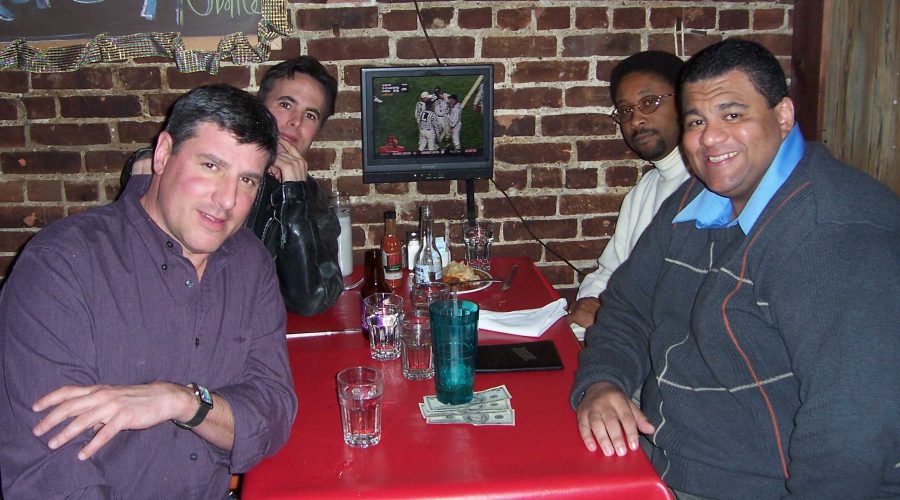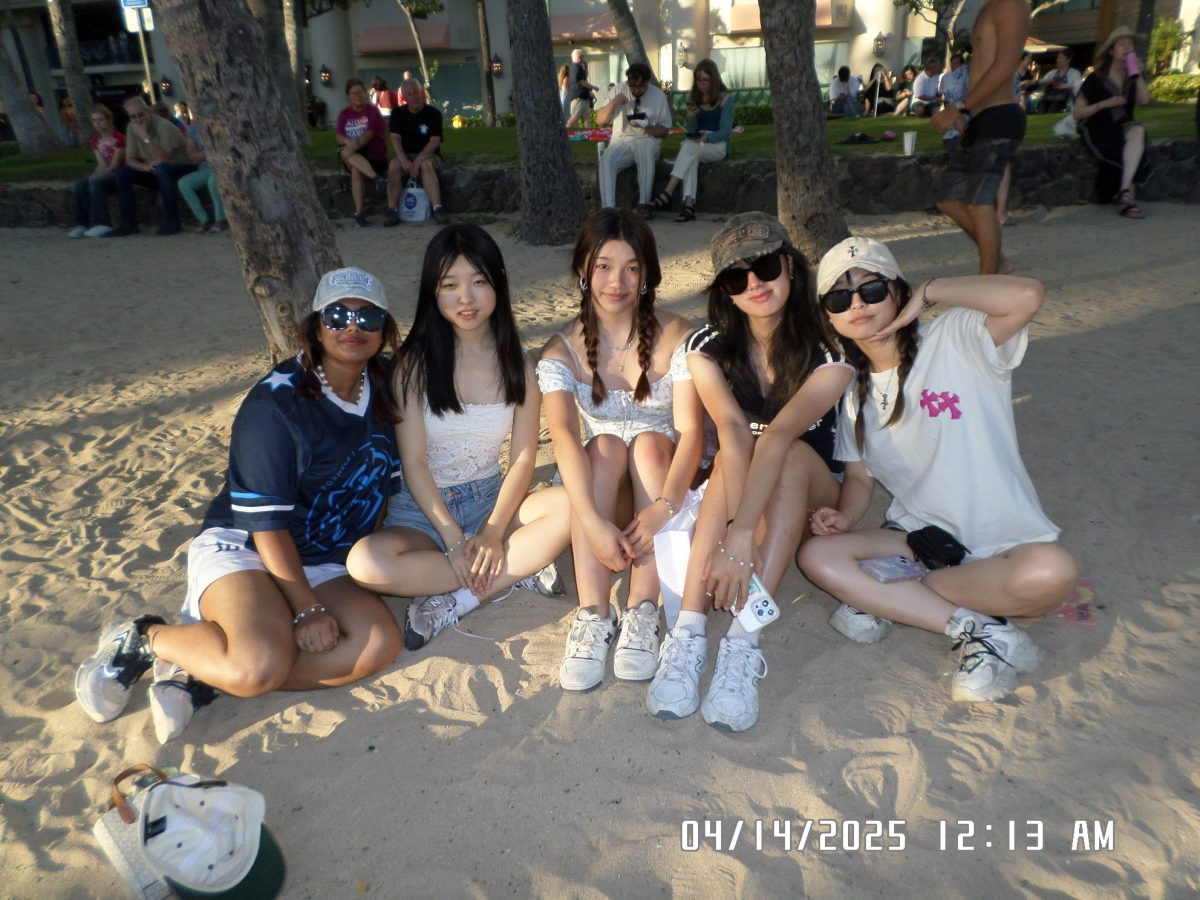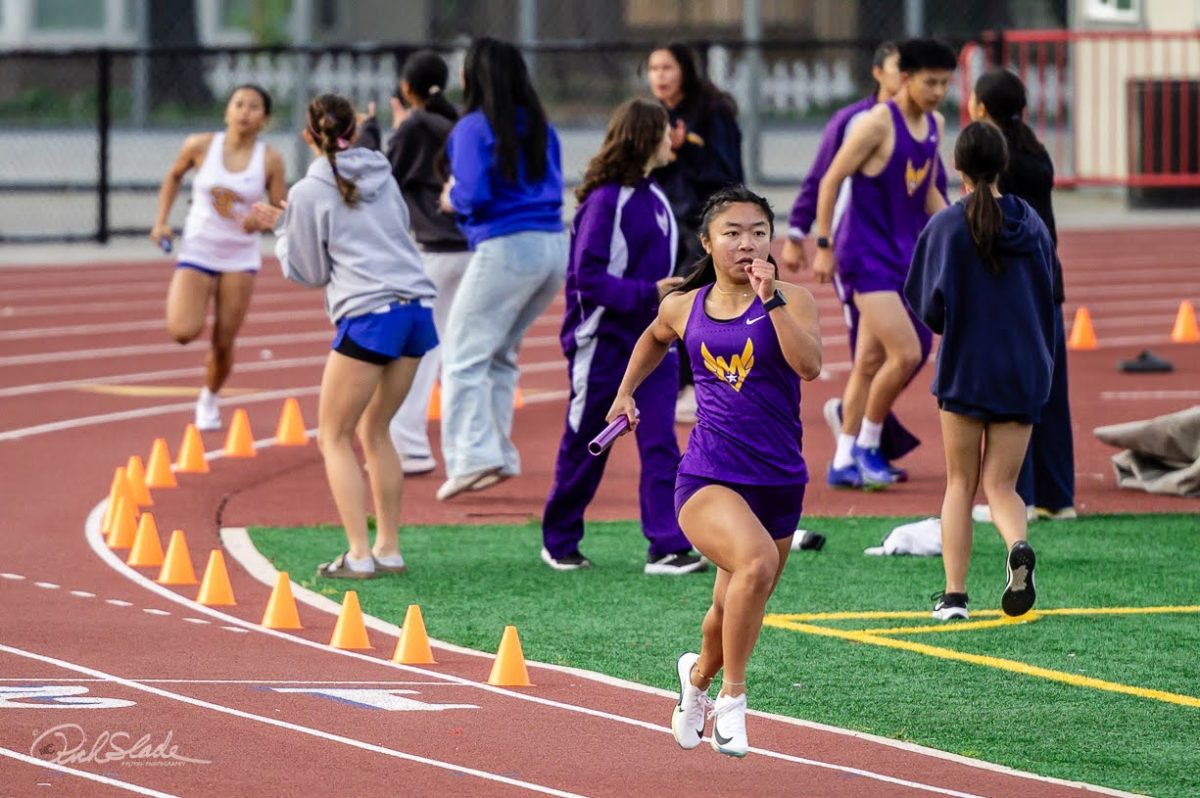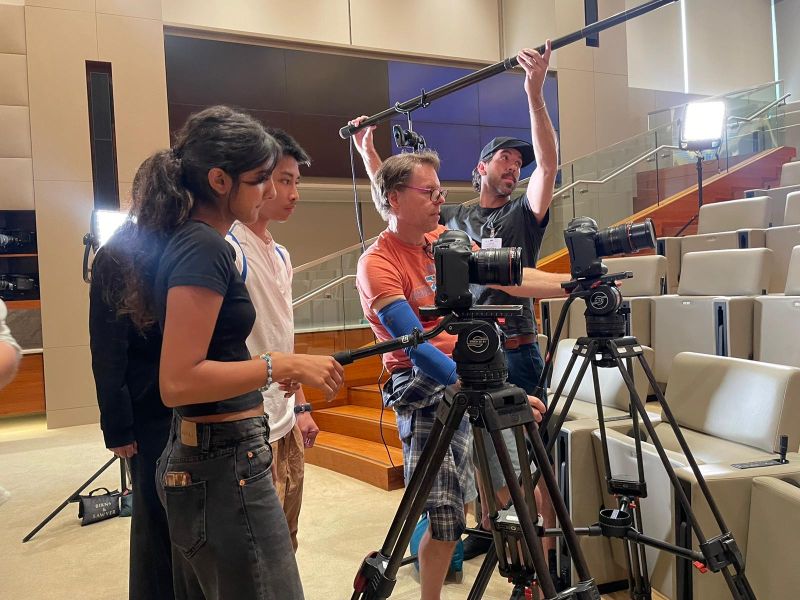
“It was just really eerie at night when you saw the glow of the smoke and all the helicopter lights,” yearbook adviser and art teacher Jay Shelton said. “The giant spotlights they put up, shining on that big empty area–that was really strange.”
When the first plane hit the North Tower at 8:46 a.m. EST, Shelton was in his classroom at a school in upstate New York. A student came running in. “A plane hit the World Trade Center!” he said. Shelton misunderstood, thinking it was a small biplane, and brushed it off. But a little while later, Shelton headed up to the library where the teachers were huddled around a television set and saw the second plane hit.
“I’m looking at this and I’m looking at the fires and they say people are dying and it’s just blowing my mind,” he said. “And then you hear about the other plane going to the Pentagon and you realize this is intentional–it’s not an accident.”
[audio:https://elestoque.org/wp-content/uploads/2011/09/not-just-the-wtc_.mp3|titles=He’s dead]“First thing I think about is Paul [Allende], because it looks [like the plane hit] just about where his office is… It was crazy because it wasn’t just the World Trade Center, it was everything around it, and I’m going, ‘Oh my God, there’s no way he got out in time. He’s dead.’”
Paul Allende’s story
In September of 2001, Shelton was teaching at a small school some three or four hours out of New York City. Shelton’s friend Paul Allende, whom he had met at Syracuse University in 1980, was at the time working on the 60th floor of the World Trade Center
After the attacks, Shelton tried to call Allende, but phone lines were down, cell phone towers were down. Throughout the day, Shelton tried again and again.
Around 3:30 p.m., the phone rang.
“Paul! You’re alive!”
“Yo, man, they’re talking about that up there?”
At around 8:10 that morning, Allende picked up a Wall Street Journal from one of the security guards in the South Tower on his way to the office where he worked as a muni trader. That security guard wouldn’t make it out of the building in time. He was one of the 3,000 who passed away that day.
At 8:46, the first plane hit the North Tower. Allende and his coworkers heard the hit and saw the concrete, papers, and office supplies flying out the adjacent building. They thought it was some kind of explosion. They didn’t know what exactly had happened.
Ten minutes later, realizing something was wrong, he and his coworkers decided to leave.
“I don’t know if it was instinctive or what,” Allende said. “But I just felt some sense of urgency, that something wasn’t right. I remember putting on my jacket, I grabbed my Wall Street Journal, and I just had a feeling…I wasn’t going to be coming upstairs anytime soon.”
They came down the stairs from the 60th to the 44th floor, the Sky Lobby. The Sky Lobby was where the elevators from the ground level ended and a separate set of elevators which went up to the higher floors began. While in the Sky Lobby, instructions came over the intercom, saying the problem was in the North Tower, and that the employees should return upstairs.
“At that point, it was sort of surreal, sort of like a movie almost,” Allende said. “While they were making that announcement, all of a sudden there was a shake and rattle and I almost fell off my feet, kind of thrown forward and [I] lost balance. That moment, we found out later, turned out to be the second plane entering our building upstairs.” The South Tower was hit at 9:03 a.m.
Allende could hear the building begin to creak. And from the way it moved, it was obvious that the building was severely damaged.
[audio:https://elestoque.org/wp-content/uploads/2011/09/stairs-still-there__.mp3|titles=Am I going to get crushed?]“I remember praying that when we [opened] the door to the stairwell that it was still going to be there,” Allende said. “I was thinking to myself that if there was no stairwell, I was wondering what would happen. Am I going to get crushed in this building? Am I gonna just be crumbled and have this building collapse on top of me?”
They walked down the remaining 44 flights of stairs. The stairwells, about the size of those in a small apartment building, were filled with people. The sheer number of employees making their way downstairs made the process slow and the atmosphere claustrophobic. It took them around 40 minutes to reach the ground level. One of Allende’s coworkers had frozen up, and he had to help her down the stairs.
On the way down, Allende and his coworkers encountered another disabled older man who was limping down the stairs. A few of the traders who worked with Allende helped carry the man down.
“They took turns [carrying him down each flight of stairs],” Allende said, “because I think they realized he was in danger of not making it out.”
As he got closer to the lobby, Allende smelled smoke and began coughing. While the employees in the building were leaving, firemen and emergency responders were running in. Out on the promenade, Allende could see the windows popping out, debris falling through the air, people jumping out from 90th floor offices.
“He got down, and when he said he got down to the bottom, he said that he didn’t stop,” Shelton said. “He didn’t look back, he didn’t look up, he didn’t do anything but [keep] walking away. And all the people who stopped and looked back got killed because [the South Tower] was the first to fall. Boom.”
Allende and his coworker walked ninety blocks—from the World Trade Center in Lower Manhattan to his cousin’s apartment in the Upper West Side—before stopping. He was all the way uptown before he called Shelton and family members. It took them two hours to walk.
“I remember people outside just standing around,” Allende said. “There were workers, there were people with food stands, bike messengers, just looking up at the building in awe. And I remember just not understanding [why they were standing there], because in my mind, I just felt the danger…you needed to get away from it.”
Two days later, Shelton and his friend Mark “Donny” Mastrangelo headed up to New York to see Allende and the wreckage. While crossing the Tappan Zee Bridge, which stretches over the Hudson River, Shelton realized the strangeness of the two towers missing from the skyline.
“I remember getting nervous,” Shelton said. “I didn’t want to see what it looked like without the World Trade Center. The next day when I was staying at Paul’s in New Jersey…it was so upsetting because I realized that I’d always used the World Trade Center as a focal point when I was figuring out where I was in New Jersey.”
At Ground Zero, there was still smoke everywhere. There were walls and walls of pictures put up by people who were searching for their loved ones. Shelton and Mastrangelo, armed with a video camera, tried to circumvent the barricades on streets and get as close as possible to the rubble. Soldiers were yelling. People were crying. Manhattan was in shambles.
At lunchtime, the two ate in a bar near one of the firehouses. The other diners had been working in the debris and were gritty and covered in soot.
“It was just really eerie, walking down near the Financial District, because you’d be in the fog and the haze, and an army guy with an automatic weapon would walk in front of you,” Shelton said. “It was just really quiet and kind of strange for New York. Still the honking, but that normal ‘people sound’ was subdued and quiet. Very eerie, very eerie.”
Afterwards, they went to see Allende, interviewing and filming him as well. Eight years earlier, on Feb. 26, 1993, a truck bomb in the subway under the North Tower detonated. Seven died and thousands were wounded. Allende was in the building at that time, too. And despite the recent trauma, Allende was still cracking jokes.
“They keep trying to kill me,” he said.
Though not physically injured, the effects of the attack were apparent. When Shelton was filming him, a television was on just to Allende’s left. Footage of the attack was playing, and when the plane hit the building, Allende turned away.
“He saw that building and realized he [was] in there,” Shelton said. “Imagine watching the film of the building right where you work. Oh man, that’s got to be weird.”
A week after Sept. 11, 2001, Allende was back at work in a makeshift office in Manhattan. Although he certainly felt the impact of what had happened, Allende wasn’t too anxious.
“I don’t think I let it traumatize me,” he said. “I think I’m a pretty strong person when it comes to that kind of thing.”
Even so, the effects of the attacks were significant. From airport security to the mentality of the American people, the nation reverberated with the aftershocks of 9/11.
“The country wanted to come together, the country wanted someone to tell then what to do,” Shelton said. “Somebody like [Bill] Clinton or [Barack] Obama probably would’ve found a way to pull us together in a very positive way, strike the proper people… and use it to make us a better people. It was apparent right away that this president was not going to do that. It was apparent right away that he had these old agendas.”
“You never forget a situation like that,” Allende said. “It was a major turn of events in the history of our country. It’s something that’s always going to be part of your life, part of who you are.”
Allende still occasionally passes by Ground Zero. He will drive by the area on the way to a business dinner or some other function, but he has never visited for the sake of visiting.
“I prefer to remember [the World Trade Center] for what it was,” he said. “I worked there for 13 years. I was very proud to work there. I was amazed and found it fascinating to look up at those buildings each and every morning…and I’d like to remember it that way. I don’t really want to rehash what happened.”
“It’s a shame,” Allende said, “that people coming to New York, and myself included, will never be able to look up and say, ‘Wow, there are the Twin Towers.’ It will never be the same.”








